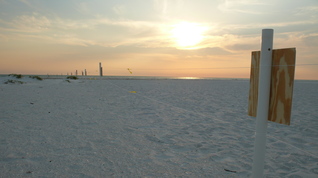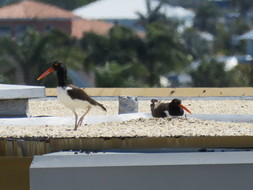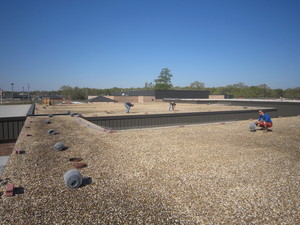Events
April 11-13: Florida Wildlife Society Conference
April 21, 9-11am: Beach-nesting Steward Training with the Lee Shorebird Partnership at Lovers Key State Park. RSVP to Courtney Kern at LeeShorebirdSteward@gmail.com.
April 22, 9am: Beach-nesting Bird Steward Training with the Collier Shorebird Partnership at Tigertail Beach on Marco Island. RSVP to Col Lauzau at CollierShorebirdStewards@gmail.com.
April 25: Beach-nesting Bird Steward Training with the St. John's/Flagler Shorebird Partnership. RSVP to Jean Rolke at rrolke@audubon.org
April 28-29: Florida Ornithological Society Spring Meeting. Tall Timbers Research Station, Tallahassee, Florida.
April date TBA:
Beach-nesting Bird Steward Training with the Timucuan Shorebird
Partnership. RSVP to Jean Olbert at Jean.Olbert@myFWC.com.
April date TBA: Rooftop Monitor Training with the Space Coast
Shorebird Partnership. RSVP to Jean Olbert at Jean.Olbert@myFWC.com
Reminder
April 15 - 21 is the April count window for the Breeding Bird Protocol.
Whenever possible, weekly surveys are preferred for routes with active nesting; it helps capture information about peak counts.
 Reporting Injured and Dead Wildlife
If you encounter an injured bird while surveying on the beach this summer, please contact your local FWC-licensed rehabilitator. If you find dead birds, do not handle them. They can be reported to the wild bird mortality database. If the bird died from entanglement, please be sure to choose that option in the "Cause of Death" section.
Also, please remember to report injured/dead sea turtles and marine mammals by calling FWC's Wildlife Alert Toll-Free Number 1-888-404-FWCC (1-888-404-3922) or for cellular phone customers: *FWC or #FWC.
Our sea turtle and marine mammal stranding networks depend on observer reports to reduce mortality of injured animals and collect/perform necropsies on dead animals to collect important data for those species.
Please be prepared to answer the following questions:
What is the exact location of the animal?
Is the animal alive or dead?
How long have you been observing the animal?
What is the species and approximate size of the animal?
If sea turtle, is it marked with spray paint?) (This may indicate that the turtle has been previously documented.)
What is the location of the public boat ramp/access point closest to the animal?
Can you provide a contact number where you can be reached for further information?
If the animal is alive, please be prepared to stay with it until help arrives. If the animal is dead, please take multiple pictures in case the animal cannot be found on a follow-up.
|
 Vegetation Removal at Posted Areas
The background: In Florida, communities and property owners who wish to rake their beaches must obtain a permit from Florida Department of Environmental Protection (FDEP). These permits are free and easy to obtain when there is no vegetation in the area to be raked. However, if vegetation is present, the permit costs $500 and requires mitigation.
The dilemma: When shorebird nesting areas are posted, the posted areas sometimes become overgrown with vegetation, thanks to extra “fertilizer” from the birds. This makes it more difficult for property owners to resume raking when the nesting season ends, creating a disincentive for them to post shorebird nesting sites.
The solution: Thanks to the work of Coastal Wildlife Conservation Initiative (CWCI), property owners who post shorebird areas can do so without fear of repercussion after the bird nesting season ends. An agreement was made so that at the end of the nesting season, property owners can return the site to its pre-posting condition without additional costs or mitigation, even if vegetation has grown in the posted area.
*Please note that these sites need to be identified to FWC and FDEP staff at the time the posting goes up and before vegetation grows.
Spread the word! Property owners may be unaware of this arrangement. We are looking for partners who are willing to talk to property owners in advance about this option early in the season (when areas are posted), or to provide contact information to us so that we can approach property owners. Help incentivize the protection of beach-nesting bird areas by making it easier for residents to return their sites to pre-posting condition. For more information, please contact Fara.Ilami@myfwc.com.
|

Are you a rooftop monitor? If so, have you updated your
rooftop site details this year?
The beginning of the season is a good time to check whether
your rooftop site details are up to date. It’s where you can tell us whether
there is a chick-checking program for that building, or if the drains are
covered. It’s also where you can describe where you stand when you survey a
building, so that anyone else monitoring that rooftop can stand in the same
place.
To update the rooftop site details:
- Go to your list of rooftops on the MyData page.
- Click the View/Edit button next to the rooftop.
- In the Site Summary box, click the View/Edit
Rooftop Management Details button. From there, you can review the
information and make any changes necessary.
-
Once you’re done, don’t forget to click Submit.
If you have a rooftop in your list that is no longer
suitable for nesting, or that you don’t monitor anymore, you can remove that
rooftop from your MyData profile. To remove a rooftop from your profile:
- Go to your list of rooftops on the MyData page.
- Click the View/Edit button next to the rooftop.
- In the Site Summary box, click the Remove
from My Data button. You can tell us why you want to remove the site,
and any additional information you think we should know.
-
Once you’re done, click the Yes, Remove from My Data
button.
Remember: removing a rooftop from your profile doesn’t
remove it from the database! It just tells us to take a closer look at that
rooftop. If the reason for removing the rooftop is because the
site is no longer suitable for nesting, we can retire it from the list of
suitable rooftops. If you’re just not visiting it anymore, removing the rooftop
is a way for you to tidy up your MyData profile, but don’t worry! The rooftop
will remain in the list of suitable rooftops so that other monitors can add it
to their profiles.
If you haven’t updated your rooftop site details in a few years, now is the time to double-check that the information we have is correct!
If you have any trouble with FSD you can always email FLShorebirdDatabase@myFWC.com.
We are happy to help!
|

 School district steps up to help protect imperiled seabirds
The Santa Rosa School District has three schools that have colonies of Least Terns and pairs of Killdeer that use their gravel rooftops as nesting grounds. These birds typically nest on sandy beaches along the Gulf of Mexico but due to beach development and increased human presence, they have found alternatively suitable habitats to raise their young. Gravel rooftops are comparable habitat to beaches because they are flat, open, and have a light colored substrate the birds can lay their eggs on.
Rooftop colonies face challenges that beach-nesting birds do not encounter. The main threat to the survival of chicks is the potential to fall off the rooftop into gutters or to the ground below. Once on the ground chicks face threats from cars, mammalian predators, and overexposure leading to dehydration and death. To avoid chicks falling off the rooftops, Audubon Florida installs a fence around the perimeter of the rooftop at willing sites. This fence is designed to have chicks stop short of the edge of the rooftop or gutters and keep them from falling to the ground.
|
 The Santa Rosa School District granted permission for Audubon Florida and Fish and Wildlife to install the chick fencing on two new schools this year to help protect the chicks from falling to the ground. The rooftop of the band building at Milton High School had over 38 Least Terns on it last year with 25 nests and a handful of fledged chicks. It also had multiple chicks fall from the rooftop and had to be returned up there once recovered. Installing a fence at this site will hopefully increase the number of chicks that survive to fledge without fear they are falling and not being found. Holley Navarre Intermediate School hosted a pair of Killdeer with three chicks and ten Least Terns that fledged two chicks in 2017. All three Killdeer chicks fell from the rooftop as well as one of the Least Tern chicks. Luckily all of the chicks were recovered and replaced before they died but with the new fencing installed all chicks that hatch out on these rooftops will face better odds of fledging than before.
We want to recognize those that go above and beyond to help protect the state listed species. A special thank you goes out to the Santa Rosa School District Assistant Superintendent, Joseph Harrell for working with Fish and Wildlife and Audubon Florida to make this project and ongoing surveying possible.
For more great stories about local businesses stepping up to protect imperiled shorebirds check out these links:
Tiny Campus Guests Inspire Huge Conservation Effort: The Nelson Poynter Memorial Library needed a new roof last year. When the construction team discovered guests on the rooftop, however, the project came to a screeching halt. The tiny guests were a colony of around 65 beach nesting birds, called Least Terns. Read more.
Local Clearwater business helps Audubon save imperiled shorebirds: Last year a handful of dedicated volunteers from
Clearwater Audubon Society visited a Least Tern rooftop colony in Clearwater
multiple times a day to rescue chicks that had fallen off the roof. Read more
|
|